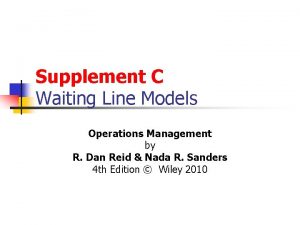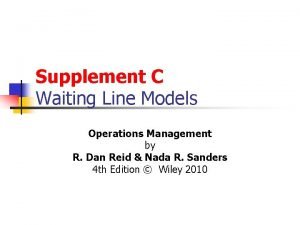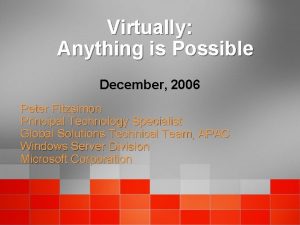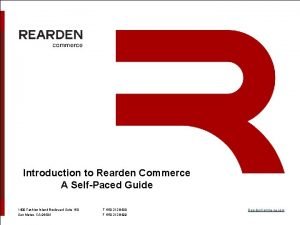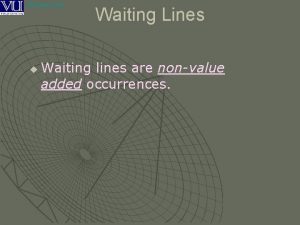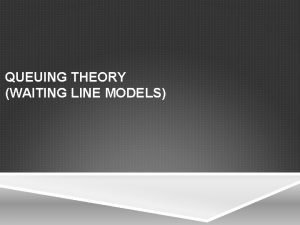Waiting Line Models Waiting takes place in virtually












- Slides: 12

Waiting Line Models Waiting takes place in virtually every productive process or service. Since the time spent by people and things waiting in line is a valuable resource, the reduction of waiting time is an important aspect of operations management. Quality Service = Quick Service More service capacity = Less waiting time = Increased Cost Goal of Queuing Theory (another name for Waiting Line theory) is to find the trade-off point between the cost of improved service and the cost of making the customer wait.

Why do waiting lines form? n People or things arrive at the server faster than they can be served. n Customers arrive at random times, and the time required to serve each individually is not the same. n What are the cost relationships in Waiting Line Analysis? n As the level of service improves, the cost of service increases n Better service requires more servers

What are the elements of a waiting line? The Calling Population - the source of the customers to the queuing system: can be either infinite or finite. The Arrival Rate - the frequency at which customers arrive at a waiting line according to a probability distribution (average arrival rate is signified by l ) Service Time - the time required to serve a customer, is most frequently described by the negative exponential distribution ( average service rate is signified by m) Queue Discipline and Length - the order in which customers are served First come, first served Last in, first out Random Alphabetically

Basic Waiting Line Structures n Four basic structures of waiting lines, determined by the nature of the service facilities. Channels are the number of parallel servers, phases denote the number of sequential servers a customer must go through to receive service. n Single channel, single phase All customers go through single server one at a time for entire process n Single channel, multiple phase - All customer go through a series of servers one at a time to complete the process. n Multiple channel, single phase - All customers get split up into a group of servers one at a time for the entire process. n Multiple channel, multiple phase - All customers get split into a group servers and further proceed through a series of servers to complete the process.

Operating Characteristics n Notation Operating Characteristics . n L Average number of customers in the system n Lq Average number of customers in the waiting line n W Average time a customer spends in the system n Wq Average time a customer spends waiting in line n P 0 Probability of no (zero) customers in the system n Pn Probability of n customers in the system n r Utilization rate; proportion of time the system is in use.

Single-Channel, Single-Phase There are several variations of the single server waiting line system: n Poisson arrival rate, exponential service times n Poisson arrival rate, general (or unknown) distribution of service times n Poisson arrival rate, constant service times n Poisson arrival rate, exponential service times with a finite queue n Poisson arrival rate, exponential service times with a finite calling population

Single-Channel, Single-Phase In our single-server model, we will assume the following: n Poisson Arrival Rate Exponential Service n Times First-come, first-serve queue discipline n Infinite queue length n Infinite calling population

Single-Channel, Single-Phase The symbols which we will use are: n n l = mean arrival rate m = mean service rate

Single-Channel, Single-Phase FORMULAS n Probability that no customers are in queuing system, P 0 = ( 1 - l/m ) n Probability that exactly n customers in the system, Pn = ( l/m )n * P 0 n Average number of customers in the system, L = ( l / m-l ) n Average number of customers in the waiting line, Lq = ( l 2 / m(m-l) n Average time a customer spend in system, W = L / l n Average time customer spends waiting in line, Wq = ( l / m(m-l) ) n Probability that the server is busy (utilization factor), r = l/m n Probability that the server is idle, I = 1 - r

Multiple-Channel, Single-Phase In our multiple-server model, we will assume the following: n Poisson Arrival Rate n Exponential Service Times n First-come, first-serve queue discipline n Infinite queue length n Infinite calling population

Multiple-Channel, Single-Phase The symbols which we will us are: n l = mean arrival rate n m = mean service rate n s = number of servers

Multiple-Channel, Single-Phase FORMULAS n Probability that no customers are in queuing system, P 0 = look to Table n Probability that exactly n customers in the system, Pn = (1/s!sn-s)*( l/m )n * P 0 for n > s Pn = ( 1/n! )*( l/m )n * P 0 for n <= s n Average number of customers in the system, L = ( lm(l/m)s / (s-1)!(sm-l )2)P 0 + l/m n Average number of customers in the waiting line, Lq = L - l/m n Average time a customer spend in system, W = L / l n Average time customer spends waiting in line to be served, Wq = W - 1 / m n Probability that the server is busy (utilization factor), r = l/sm n Probability that the server is idle and customer can be served, I = 1 - r
 Waiting line models operations management
Waiting line models operations management Waiting line models operations management
Waiting line models operations management Internal and external assessment in strategic management
Internal and external assessment in strategic management Virtually anything is possible
Virtually anything is possible Competition in virtually all industries is
Competition in virtually all industries is Sabre virtually there
Sabre virtually there Rearden personal assistant
Rearden personal assistant Lutgens and tarbuck
Lutgens and tarbuck The characters struggle takes place
The characters struggle takes place Ratatouille movie restaurant name
Ratatouille movie restaurant name What is the word equation of photosynthesis
What is the word equation of photosynthesis Photosynthesis takes place in
Photosynthesis takes place in Random orientation of homologous chromosomes
Random orientation of homologous chromosomes
